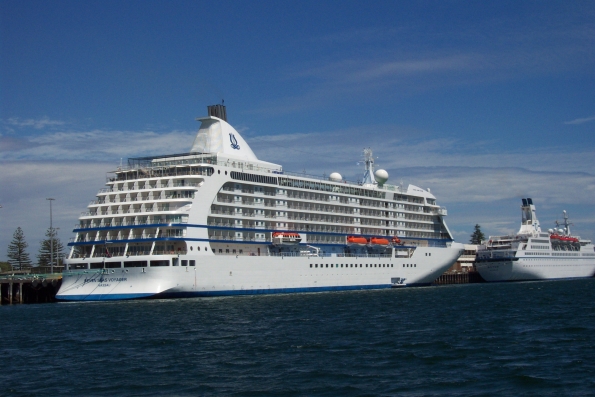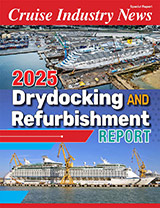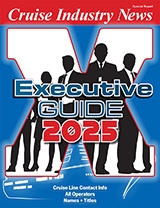 Radisson Seven Seas Cruises (RSSC) is being re-branded and is expected to have a new name next year, positioning the cruise line closer to the luxury hotels in the Carlson group. But the product formula will not change.
Radisson Seven Seas Cruises (RSSC) is being re-branded and is expected to have a new name next year, positioning the cruise line closer to the luxury hotels in the Carlson group. But the product formula will not change.
“We believe that around 700 passengers are ideal,” said Mark Conroy, CEO of RSSC. “We could build bigger ships with more suites, but will not carry more passengers. We do not believe you can deliver our level of service to more people.”
According to Conroy, the vision of the Carlson Companies is that RSSC can be a billion dollar business. So far, the cruise line is in the $400 million a year range – with business this year up $70 million over last year.
“We are seeing big increases in every market we put ships into,” Conroy added. “And people are willing to pay. Alaska has been spectacular for us this year, and the Baltic too – both were sold out.”
RSSC was getting per diems of $600 in Alaska this past summer – for a luxury product with no formal nights and so many children onboard that the line has had to design a children’s program.
“We drive higher rates with better cabins and more personal service. While our standard cabins are very nice, the concept of suites and butler service motivates people to book up. We have butlers from India who have work experience from the palaces of the Middle East,” Conroy added.
While there is price competition with the mass market, “if guests could compare apples to apples, we would come out ahead, with all that is included,” Conroy said. Price is particularly an issue in the Caribbean, where RSSC’s longer cruises nevertheless fill up at good prices.
“We have a great proposition,” he continued. “Mass- and premium-market ships today are much better than they were 10 years ago, but with masses of people, it is difficult to get on and off these ships.
“We do everything possible so passengers shall not wait in line.
“As the mass market creates a pool of passengers, we need to communicate and convince them that there are alternatives,” Conroy continued.
The luxury market is less than 3 percent of the cruise market, according to Conroy, who said the luxury lines had a 5 percent market share when RSSC was launched. The luxury market is not elastic, he said, and has actually contracted as the overall cruise market has grown.
But the market who can afford his cruises is huge – and he needs to market more. Part of that effort includes shorter cruises to introduce RSSC to new guests and convince them to trade up.
“Once we get somebody to migrate, they never go back,” Conroy said. “Forty percent of our guests are repeaters.
“They expect attention to details and service.”
The key is to communicate with the guests, Conroy explained. “We have conversations with our guests and we listen to what they are looking for – such as personal service, choices and flexibility.
“Our luxury premise is to offer consistent service and food on all our ships and all our cruises.
“Our customers used to want the same things every year. But people are changing. Now they want different things.”
Thus, RSSC “invented” a trans-Pacific cruise, for example, that Conroy said is sold out.
For 2005, RSSC’s 109-day world cruise was already sold out by the end of this past summer. With 90 percent American guests, the cruise will include a call in Dubai and will also sail through the Suez, calling in Egypt. Three hundred and fifty-four guests have booked the full cruise. The rest have booked segments, but most are sailing more than one segment.
RSSC also plans to go back to Europe in a big way, according to Conroy, including a 56-day cruise round-trip from New York that includes calls in Reykjavik, Spitzbergen, at the North Cape, St. Petersburg and Copenhagen. Segments are also available.
Bermuda cruises will also be offered next year, with 12 sailings, and with passengers embarking and disembarking in both New York and Norfolk. The Seven Seas Navigator sails from New York on Wednesdays.
RSSC also plans to continue to sail from a variety of North American ports, including Vancouver, Ft. Lauderdale, New York, Norfolk, Los Angeles and Montreal.
Tahiti has perhaps been RSSC’s biggest challenge. Sailing the Paul Gauguin year-round there, Renaissance Cruises came in with heavy discounting, Conroy said. And now, with Renaissance gone, Princess Cruises is sailing out of Tahiti and is a formidable competitor, he added.
Yet, with Paul Gauguin rated the number one ship in the world, Conroy is confident that the product he delivers is top of the class. Next year, RSSC will be offering some 10- and 11-day cruises as well. “Some people do not what to fly that far just for a seven-day cruise,” he explained.
The key to itinerary planning, however, is to be in the right place at the right time, according to Conroy, who said that RSSC was in the process of finalizing its 2006 itineraries.
Another aspect that RSSC is working on is to match the shoreside guest experiences offered by RSSC closer to the shipside experience. Looking forward, Conroy said the company will expand with more new ships only when it decides that the time is right. Meanwhile, RSSC has an option with T. Mariotti which expires at the end of this year.
Conroy described RSSC as a boutique line, and said he does not worry about market share.
“When I can fill all our cruises, it may be time to order, but the euro-dollar rate is also a detriment to ordering,” Conroy said. “When we ordered the Seven Seas Voyager, the euro was $0.84, now it is $1.20, adding $50 million to the cost of the same ship.”
RSSC is owned by the Carlson Companies and the ships are owned jointly by Carlson and V. Ships, with V. Ships also providing ship management services, marine operations, and crewing.
The objective of the re-branding is to position RSSC clearly at the top of the market, including a new name that is more clearly associated with luxury.
Conroy pointed out that to grow successfully, the company must stay focused on the customer – as well as on the crew, the destinations and the hardware. – Oivind Mathisen
Excerpt from the Cruise Industry News Quarterly Magazine: Fall 2004





